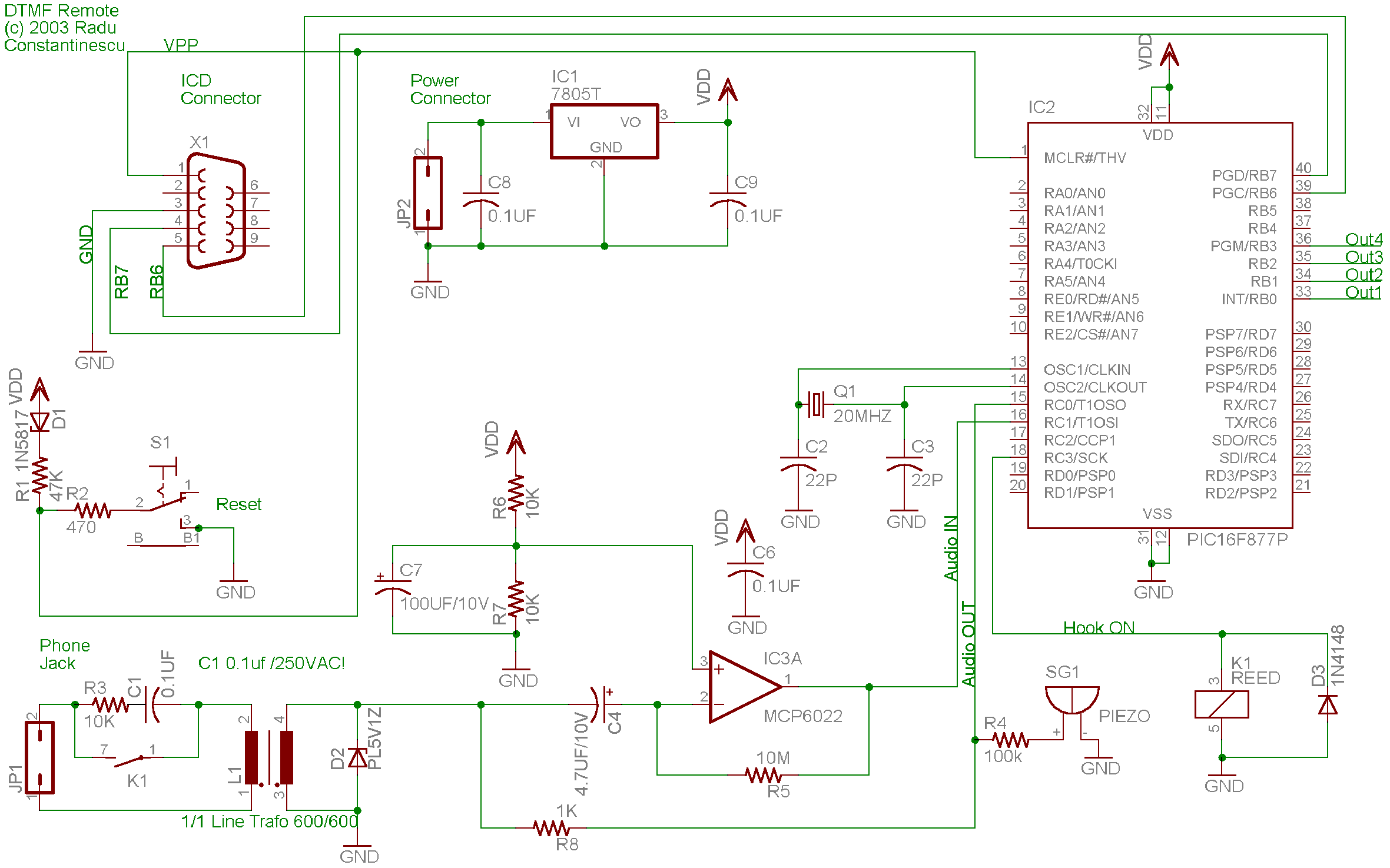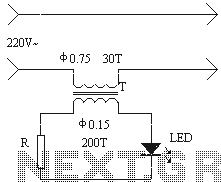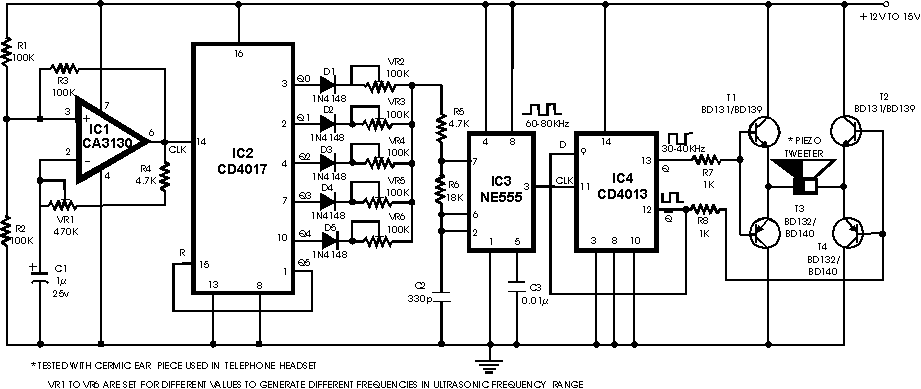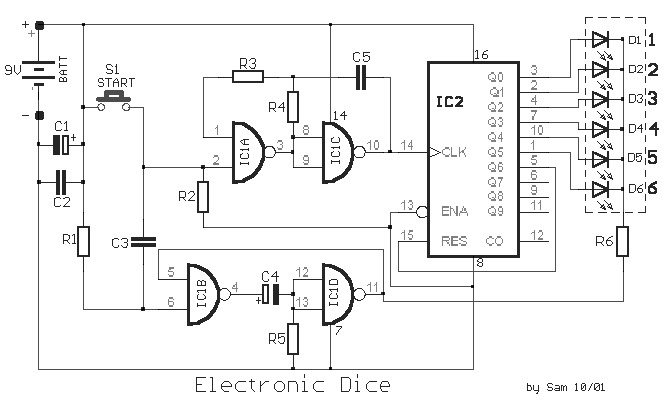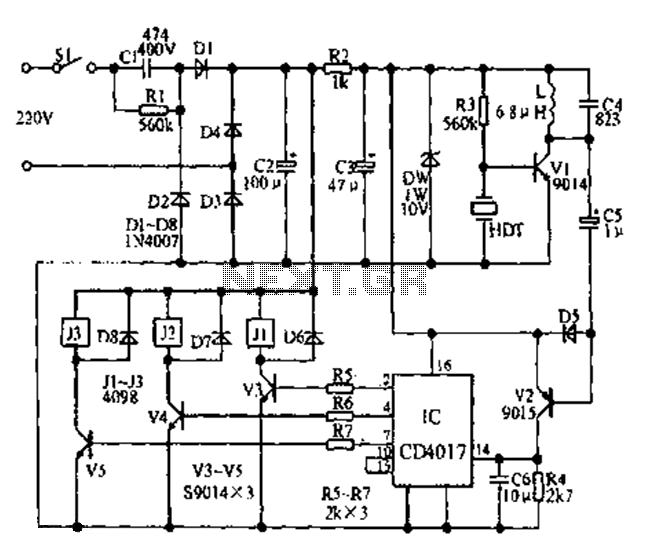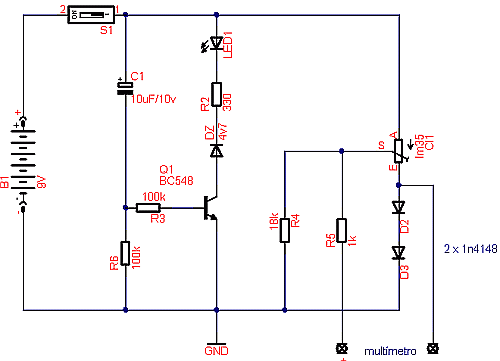
Simple Analog Multiplier Circuit Using LM107
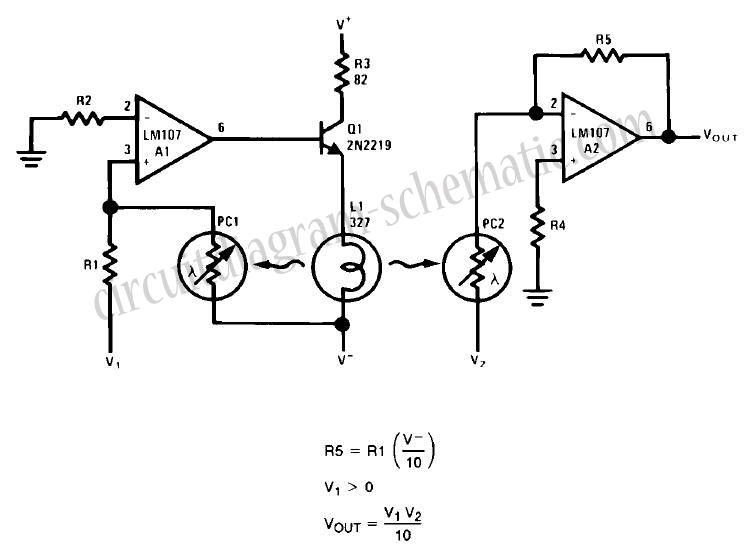
This circuit is a simple analog multiplier. The operation of the circuit can be understood by considering A2 as a controlled gain amplifier that amplifies V2, with its gain dependent on the ratio of the resistance of PC2 to R5. A1 functions as a control amplifier that establishes the resistance of PC2 as a function of V1. Consequently, VOUT is influenced by both V1 and V2. A1 provides drive for the lamp, L1. When an input voltage, V1, is present, L1 is activated by A1 until the current flowing to the summing junction from the negative supply through PC1 equals the current from V1 through R1. Given that the negative supply voltage is fixed, this condition forces the resistance of PC1 to a value proportional to R1 and the ratio of V1 to V-. L1 also illuminates PC2, and if the photoconductors are matched, it causes PC2 to have a resistance equal to PC1. A2, the controlled gain amplifier, functions as an inverting amplifier whose gain is the ratio of the resistance of PC2 to R5. If R5 is selected to equal the product of R1 and V-, then VOUT simplifies to the product of V1 and V2. R5 can be scaled in powers of ten to achieve any desired output scale factor. The circuit configuration provides an inverting output whose magnitude is one-tenth of the product of the two analog inputs. Input V1 is limited to positive values, while V2 can take on both positive and negative values. The circuit is designed for low-frequency operation, constrained by the lamp's time constant. R2 and R4 are selected to minimize errors caused by input offset current, as discussed in the photocell amplifier section. R3 is included to limit inrush current when initially powering the lamp, L1.
This analog multiplier circuit utilizes a combination of operational amplifiers and photoconductive elements to achieve its functionality. The core components include two operational amplifiers, A1 and A2, which serve distinct roles within the circuit. A1 acts as a control amplifier, monitoring the input voltage V1 and adjusting the resistance of PC2 accordingly. This feedback mechanism ensures that the resistance of PC2 is dynamically altered in response to V1, thereby influencing the overall gain of the system.
A2 serves as the controlled gain amplifier, where the gain is determined by the resistance of PC2 in relation to a fixed resistor, R5. The design allows for flexibility in output scaling, as R5 can be varied to achieve different output levels, making the circuit adaptable for various applications. The inverting nature of A2 means that the output voltage, VOUT, will be negative relative to the inputs, providing a straightforward relationship between the input voltages and the output.
The inclusion of the lamp, L1, plays a critical role in the circuit's operation. It not only provides the necessary light to activate PC2 but also acts as a current driver for the circuit. The design ensures that L1 is energized in accordance with the input signal V1, allowing for precise control over the circuit's response. The use of resistors R2 and R4 is crucial for maintaining accuracy by compensating for input offset currents, which can introduce errors in measurement.
Additionally, R3 is strategically placed to mitigate inrush current during the initial power-up phase, protecting the circuit components and ensuring stable operation. Overall, this analog multiplier circuit exemplifies a well-thought-out design that integrates various electronic components to achieve a specific function while allowing for adjustments based on application requirements.This circuit a simple analog multiplier, the circuit operation may be understood by considering A2 as a controlled gain amplifier, amplifying V2, whose gain is dependent on the ratio of the resistance of PC2 to R5 and by considering A1 as a control amplifier which establishes the resistance of PC2 as a function of V 1. In this way it is seen that VOUT is a function of both V1 and V2. A1, the control amplifier, provides drive for the lamp, L1. When an input voltage, V1, is present, L1 is driven by A1 until the current to the summing junction from the negative supply through PC1 is equal to the current to the summing junction from V1 through R1. Here is a schematic drawing : Since the negative supply voltage is fixed, this forces the resistance of PC1 to a value proportional to R1 and to the ratio of V1 to V -.
L1 also illuminates PC2 and, if the photoconductors are matched, causes PC2 to have a resistance equal to PC1. A2, the controlled gain amplifier, acts as an inverting amplifier whose gain is equal to the ratio of the resistance of PC2 to R5.
If R5 is chosen equal to the product of R1 and V-, then VOUT becomes simply the product of V1 and V2. R5 may be scaled in powers of ten to provide any required output scale factor. The circuit as shown gives an inverting output whose magnitude is equal to one-tenth the product of the two analog inputs.
Input V 1 is restricted to positive values, but V2 may assume both positive and negative values. This circuit is restricted to low frequency operation by the lamp time constant. R2 and R4 are chosen to minimize errors due to input offset current as outlined in the section describing the photocell amplifier. R3 is included to reduce in-rush current when first turning on the lamp, L1. 🔗 External reference
This analog multiplier circuit utilizes a combination of operational amplifiers and photoconductive elements to achieve its functionality. The core components include two operational amplifiers, A1 and A2, which serve distinct roles within the circuit. A1 acts as a control amplifier, monitoring the input voltage V1 and adjusting the resistance of PC2 accordingly. This feedback mechanism ensures that the resistance of PC2 is dynamically altered in response to V1, thereby influencing the overall gain of the system.
A2 serves as the controlled gain amplifier, where the gain is determined by the resistance of PC2 in relation to a fixed resistor, R5. The design allows for flexibility in output scaling, as R5 can be varied to achieve different output levels, making the circuit adaptable for various applications. The inverting nature of A2 means that the output voltage, VOUT, will be negative relative to the inputs, providing a straightforward relationship between the input voltages and the output.
The inclusion of the lamp, L1, plays a critical role in the circuit's operation. It not only provides the necessary light to activate PC2 but also acts as a current driver for the circuit. The design ensures that L1 is energized in accordance with the input signal V1, allowing for precise control over the circuit's response. The use of resistors R2 and R4 is crucial for maintaining accuracy by compensating for input offset currents, which can introduce errors in measurement.
Additionally, R3 is strategically placed to mitigate inrush current during the initial power-up phase, protecting the circuit components and ensuring stable operation. Overall, this analog multiplier circuit exemplifies a well-thought-out design that integrates various electronic components to achieve a specific function while allowing for adjustments based on application requirements.This circuit a simple analog multiplier, the circuit operation may be understood by considering A2 as a controlled gain amplifier, amplifying V2, whose gain is dependent on the ratio of the resistance of PC2 to R5 and by considering A1 as a control amplifier which establishes the resistance of PC2 as a function of V 1. In this way it is seen that VOUT is a function of both V1 and V2. A1, the control amplifier, provides drive for the lamp, L1. When an input voltage, V1, is present, L1 is driven by A1 until the current to the summing junction from the negative supply through PC1 is equal to the current to the summing junction from V1 through R1. Here is a schematic drawing : Since the negative supply voltage is fixed, this forces the resistance of PC1 to a value proportional to R1 and to the ratio of V1 to V -.
L1 also illuminates PC2 and, if the photoconductors are matched, causes PC2 to have a resistance equal to PC1. A2, the controlled gain amplifier, acts as an inverting amplifier whose gain is equal to the ratio of the resistance of PC2 to R5.
If R5 is chosen equal to the product of R1 and V-, then VOUT becomes simply the product of V1 and V2. R5 may be scaled in powers of ten to provide any required output scale factor. The circuit as shown gives an inverting output whose magnitude is equal to one-tenth the product of the two analog inputs.
Input V 1 is restricted to positive values, but V2 may assume both positive and negative values. This circuit is restricted to low frequency operation by the lamp time constant. R2 and R4 are chosen to minimize errors due to input offset current as outlined in the section describing the photocell amplifier. R3 is included to reduce in-rush current when first turning on the lamp, L1. 🔗 External reference
Warning: include(partials/cookie-banner.php): Failed to open stream: Permission denied in /var/www/html/nextgr/view-circuit.php on line 713
Warning: include(): Failed opening 'partials/cookie-banner.php' for inclusion (include_path='.:/usr/share/php') in /var/www/html/nextgr/view-circuit.php on line 713
